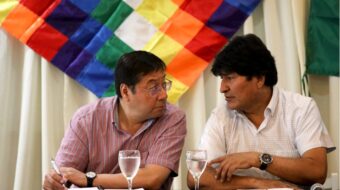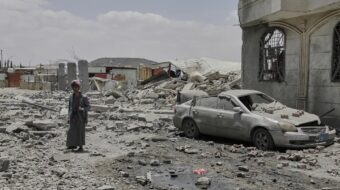Thousands of protesters, organized by the Piraeus committee of the Greek Committee for International Peace and Détente, massed for two days of demonstrations against the presence offshore of the NATO Standing Naval Force of the Mediterranean. Protesters also targeted the Greek government and the presidency of the European Union with their slogans. Other initiators included Youth Action for Peace, the Action-Thessaloniki 2003 campaign, the left-led labor federation PAME, and dozens of other organizations.
Very early in the morning on Feb. 19, the Communist Party of Greece and the left-led PAME labor federation hung two huge banners visible from the sea, saying “NATO killers go home” and “NATO fleet is not welcome.” The first march, which started at 10 a.m., was followed by another at 5 p.m., with protesters staying far into the night, holding torches that could be seen from the ships.
On the evening of Feb. 20, the protest continued with one of the biggest demonstrations in the city’s history.
As a result, the Greek government was forced to appeal to the commander of the fleet of U.S., Spanish, Turkish, Dutch and Italian vessels, not to enter the harbor.
On Feb. 20, the German vessel tried to dock at a secondary port in a suburb of Piraeus to take on supplies. Members of the seamen’s unions immediately gathered at the dock, together with area young people. As a result, the ship left in midday, empty-handed.
During a press conference, Feb. 20, aboard the NATO fleet’s flagship, Greek journalists presented U.S. Admiral Gregory G. Johnson, commander of the NATO forces in Southern Europe, with a statement protesting any attack on Iraq, opposing the role of NATO and emphasizing the popular opposition to the fleet’s presence in Piraeus.









